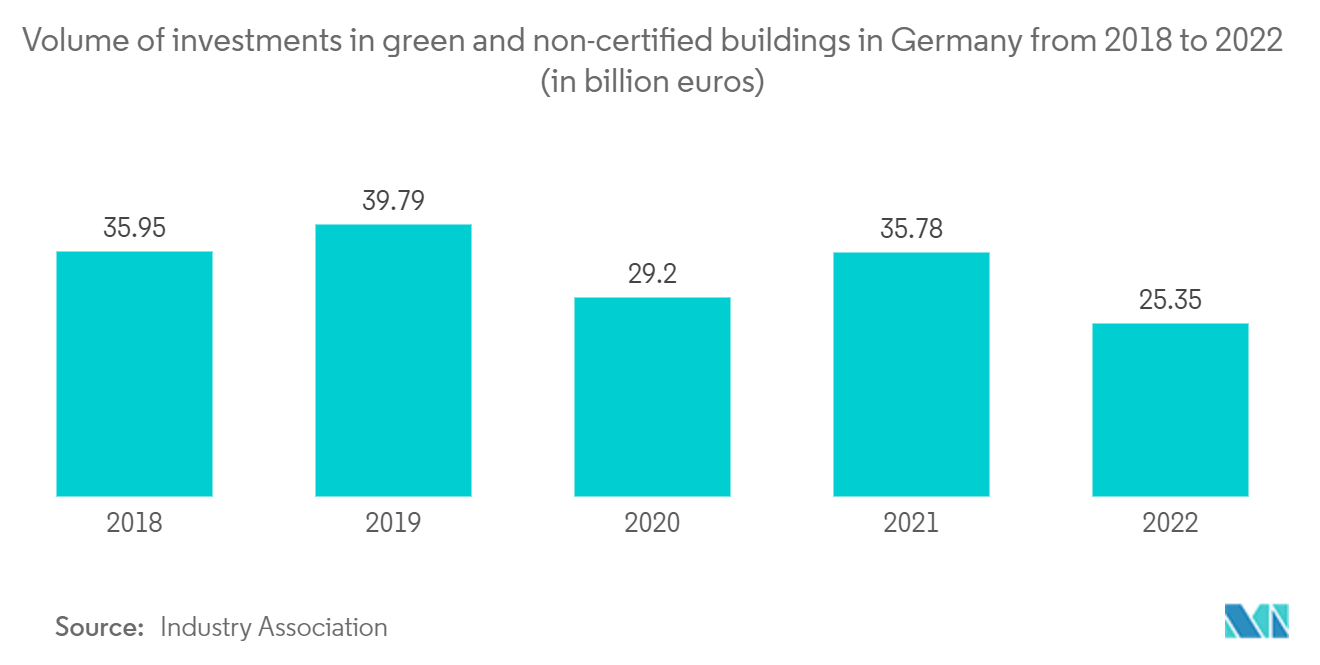Market Trends of Europe Green Buildings Industry
Increase in Non-residential Market
There is a wide range of different typologies in the nonresidential sector. This includes wholesale and retail (28% of the total), offices (23%), educational (17%), hotels and restaurants (11%), hospitals (7%), sports facilities (4%), and other buildings (11%) such as warehousing, transportation and garage buildings, agricultural (farms, greenhouses) buildings, garden buildings.
The diversity of typologies in this sector presents a high degree of complexity regarding energy use, given that end uses like lighting, ventilation, heating, cooling, refrigeration, IT equipment, and appliances differ widely from one building category to another across different countries.
Real estate developer AFI Europe obtained the LEED v4.1 O+M certification for its AFI Cotroceni mall in Bucharest. Colliers helped the company to obtain environmental certificates. An ongoing commitment to the implementation of sustainable practices initiated during the certification process, with a requirement to renew every three years, is the LEED v4.1 Operations + Maintenance O+M certification.
The United Kingdom has set ambitious targets to combat climate change and promote sustainable development. One of the critical areas where the United Kingdom is focusing its efforts is in the building and renewable energy sectors.
The UK's targets for sustainable building and renewable energy are amongst the most ambitious in Europe, where it currently ranks 6th when it comes to wind and solar power production. Several other European countries have set more ambitious targets. For instance, Sweden aims to reach net zero emissions by 2045, and Denmark aims for 100% renewable energy production by 2030.
Hence, the non-residential sector in Europe can potentially be a significant driver of the green buildings market by increasing demand for sustainable construction, adapting green practices, and collaborating for further innovations. the Europe can create a thriving market for environmental responsible living spaces contributing to a greener future.

Germany's Strong Demand for Green Buildings
Some of the world's most impressive sustainable architecture and eco-friendly buildings can be found in Germany. The country has made significant progress in creating a greener future, from innovative design to energy-efficient construction techniques.
Creative and environmentally conscious designs can be seen in the country's commitment to environment-friendly architecture and sustainable building materials. From office complexes to residential homes, Germany's green buildings showcase the integration of energy-efficient systems, passive solar design principles, and non-toxic finishes.
One noteworthy example is the EDGE Suedkreuz building in Berlin, certified in 2022 as Germany's most sustainable building by the German Sustainable Building Council (DGNB). It is one of the most significant buildings of its kind in Europe, thanks to its modular hybrid timber construction. With a DGNB Platinum rating, the EDGE Suedkreuz utilizes a range of eco-friendly features, including a carbon-capturing facade, biophilic atrium, and energy-efficient systems.
The development of Solarsiedlung and Sonnenschiff in Freiburg. These projects show how, through integrating Green Infrastructures in Urban Plans, Germany creates sustainable communities. Solarsiedlung, or solar settlement, is a residential neighborhood that uses the sun's energy for electricity and heating.
In 2022, most of the investments in green buildings in Germany were for office space. Logistics was the end use with the second biggest share of green building investments. There was almost 1.5 billion euros of green building investments for logistics, and roughly EUR 150 million for hotels. In 2022, the investment in green buildings in Germany made a significant share of the overall investment.
The German government is taking several steps to boost the green building market driven by its commitment to its sustainability and environmental protection. By implementing these initiavtes the Germany is aiming to establish as a global leader in sustainable construction.


